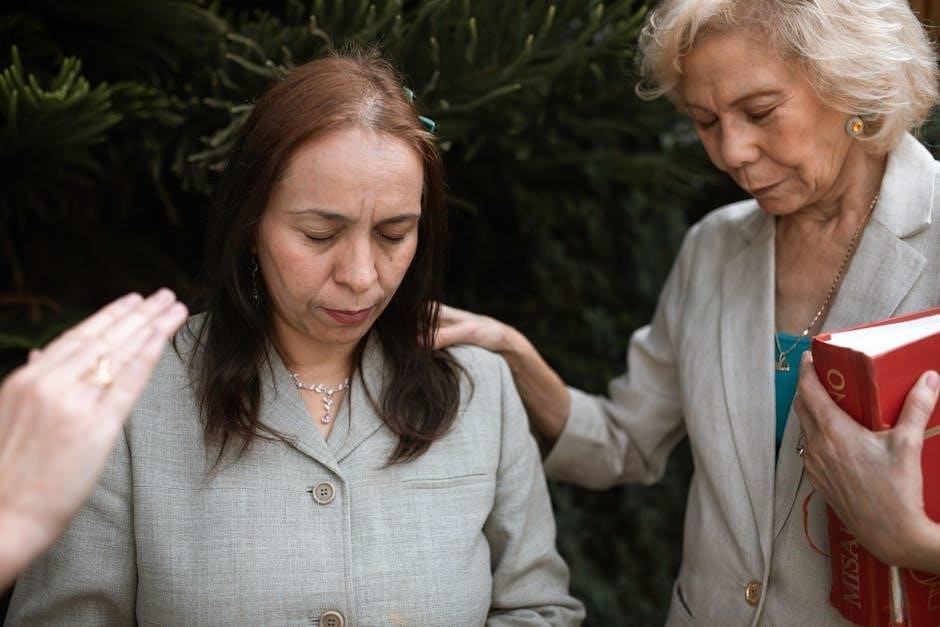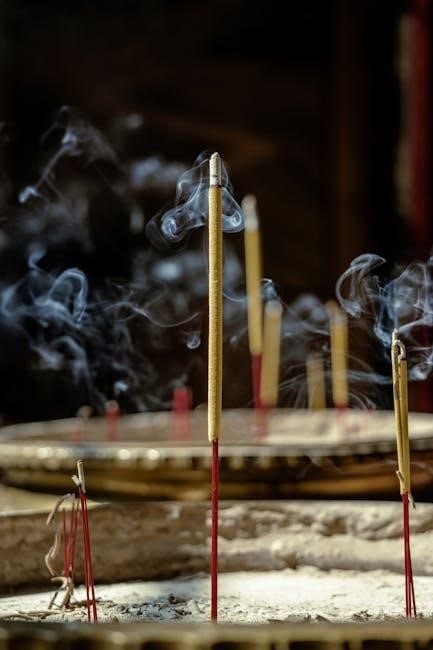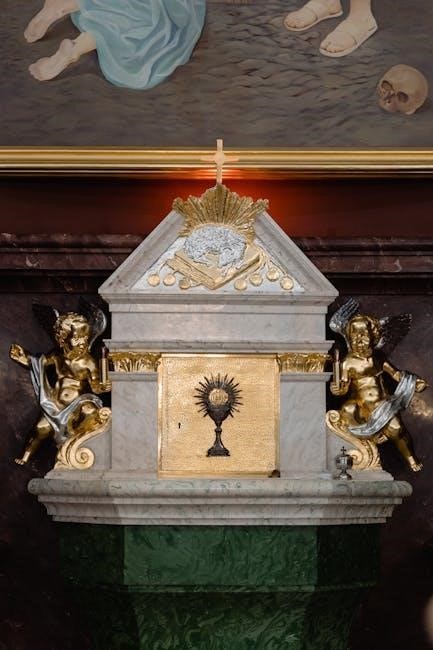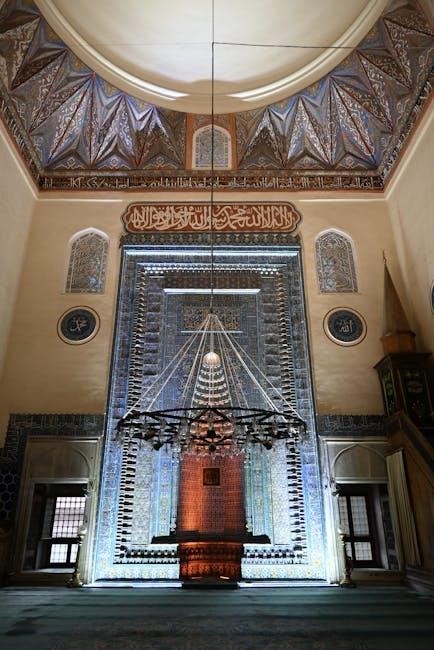
-
By:
- ruby
- No comment
tabernacle prayer guide
The Tabernacle Prayer Guide offers a structured approach to deepen your prayer life‚ drawing inspiration from the biblical Tabernacle’s design and symbolism to connect with God’s presence.
1.1 Understanding the Tabernacle as a Symbol of God’s Presence
The Tabernacle‚ as described in the Bible‚ was a sacred structure designed to symbolize God’s presence among His people. It served as a physical representation of God’s desire to dwell with humanity‚ creating a space for worship‚ sacrifice‚ and communion. The intricate design and specific instructions for its construction highlight its divine significance‚ pointing to God’s holiness and humanity’s need for atonement. The Tabernacle’s elements‚ such as the altar and veil‚ symbolize access to God’s presence‚ emphasizing sacrifice and reverence. By studying its structure‚ believers can gain deeper insights into God’s nature and humanity’s relationship with Him‚ fostering a meaningful prayer life.
1.2 The Purpose of the Tabernacle in Prayer
The Tabernacle serves as a powerful model for prayer‚ offering a structured approach to connect with God. Its design symbolizes the journey into God’s presence‚ guiding believers through sacrifice‚ intercession‚ cleansing‚ and communion. By aligning prayer with the Tabernacle’s elements‚ such as the altar and incense‚ one can experience a deeper‚ more intentional prayer life‚ fostering intimacy and holiness.
The Altar of Sacrifice
The Altar of Sacrifice symbolizes the heart of prayer‚ representing surrender and consecration to God. It reflects Christ’s ultimate sacrifice‚ teaching believers to offer their lives as a living sacrifice in prayer and devotion.
2.1 The Significance of Sacrifice in Prayer
The Altar of Sacrifice embodies surrender and consecration‚ reflecting Christ’s ultimate sacrifice for humanity. Sacrifice in prayer involves yielding our will‚ desires‚ and lives to God‚ acknowledging His sovereignty. It teaches us to offer heartfelt prayers‚ confess sins‚ and dedicate ourselves to His purpose‚ mirroring the biblical act of laying offerings before God. This practice deepens our humility and commitment to Him.
2.2 How to Pray with a Spirit of Surrender
Praying with surrender involves laying down your desires‚ fears‚ and control‚ offering them to God. Begin by confessing sins and yielding your heart to His will. Acknowledge His sovereignty and seek His purpose in your life. Surrendering in prayer fosters humility‚ trust‚ and dependence on God‚ aligning your spirit with His plan and bringing renewal and freedom.

The Altar of Incense
The Altar of Incense symbolizes prayer and worship‚ located in the Holy Place‚ its fragrance represents the ascent of prayers to God‚ deepening divine connection.
3.1 The Role of Intercession in Prayer
The Altar of Incense represents the heart of intercession‚ where prayers ascend to God like fragrant incense. Intercession is a vital part of prayer‚ bridging the gap between humanity and divinity. It reflects Jesus’ role as our High Priest‚ interceding on our behalf. Through intercession‚ we pray for others‚ seeking God’s will and breakthroughs‚ aligning our hearts with His divine purpose.
3.2 Praying with Incense as a Symbol of Worship
Praying with incense symbolizes worship‚ as its fragrant smoke ascends to heaven‚ representing prayers lifted to God. This practice reflects reverence and devotion‚ creating a sacred atmosphere for communion with God. Like the priests who tended the Altar of Incense‚ believers today can use this symbol to focus their hearts on worship‚ acknowledging God’s holiness and grace in their lives.
The Laver of Cleansing
The Laver of Cleansing symbolizes purification and repentance‚ reminding us to seek spiritual cleansing before approaching God in prayer. It represents washing away sin and preparing the heart for worship.
4.1 The Importance of Repentance in Prayer
Repentance is essential for spiritual cleansing‚ enabling believers to approach God with a pure heart. It involves acknowledging sin‚ seeking forgiveness‚ and turning away from wrongdoing. Through repentance‚ we prepare ourselves to worship and pray effectively‚ aligning our hearts with God’s holiness. This step is vital for maintaining a genuine connection with Him.
4.2 How to Pray for Cleansing and Renewal
To pray for cleansing and renewal‚ begin by acknowledging your sins and humbly confessing them before God. Seek His forgiveness with a repentant heart‚ asking for purification through His grace. Invite the Holy Spirit to renew your mind and spirit‚ empowering you to walk in righteousness. This prayer restores your relationship with God‚ bringing spiritual refreshment and clarity.

The Holy Place
The Holy Place symbolizes entering God’s presence with thanksgiving and reverence‚ where prayer is illuminated by His holiness‚ guiding believers to seek His divine light.
5.1 Entering God’s Presence with Thanksgiving
Entering God’s presence with thanksgiving is a foundational aspect of prayer‚ reflecting the Holy Place’s symbolism. Gratitude aligns our hearts with God’s will‚ fostering intimacy and reverence. By focusing on His blessings‚ we create a sacred space for communion‚ mirroring the Tabernacle’s design. This practice deepens our connection‚ inviting God’s light to illuminate our prayers and guide our worship.
5.2 Praying in the Light of God’s Holiness
Praying in the light of God’s holiness involves recognizing His divine nature and aligning our prayers with reverence. The Tabernacle’s Holy Place‚ filled with golden instruments‚ symbolizes purity and divine presence. By acknowledging God’s holiness‚ we approach prayer with humility and sincerity‚ allowing His light to guide our words and actions‚ fostering a deeper connection with Him.

The Veil and the Holy of Holies
The veil and Holy of Holies symbolize access to God’s presence. Through Jesus’ sacrifice‚ the veil was torn‚ granting believers access to God with boldness and confidence.
6.1 The Veil as a Symbol of Access to God
The veil in the Tabernacle represented a barrier between God’s presence and humanity‚ signifying the holiness and transcendence of God. Its tearing at Christ’s crucifixion symbolized the removal of this barrier‚ granting believers direct access to God’s presence. This profound act embodies the invitation to approach God with boldness and confidence‚ knowing that Jesus has made the way open for intimate communion with the Father.
6.2 Praying with Boldness and Confidence
The torn veil symbolizes Christ’s sacrifice‚ granting believers direct access to God’s presence. This truth emboldens us to pray with confidence‚ knowing we approach a loving Father through Jesus. Pray with authority‚ trusting in God’s grace and provision‚ and rely on His faithfulness to guide and empower your life.
The Ark of the Covenant
The Ark of the Covenant‚ housing the Ten Commandments‚ symbolizes God’s covenant with His people‚ representing His presence and faithfulness‚ guiding prayer and trust in His promises.
7.1 The Ark as a Representation of God’s Covenant
The Ark of the Covenant‚ adorned with golden cherubim‚ symbolized God’s divine covenant with His people. Housing the Ten Commandments‚ Aaron’s rod‚ and manna‚ it represented God’s faithfulness and the foundation of His relationship with Israel. This sacred vessel served as a visual reminder of God’s promises‚ inspiring trust and reverence in prayer‚ and pointing to His enduring faithfulness.
7.2 Praying with Faith in God’s Promises
Praying with faith in God’s promises involves trusting His covenant and aligning your heart with His will. Just as the Ark held the Ten Commandments‚ manna‚ and Aaron’s rod‚ it reminds us of God’s faithfulness. In prayer‚ declare His promises‚ thank Him for His provision‚ and seek guidance with confidence‚ knowing He directs those who trust Him and His eternal plans.

The Table of Showbread
The Table of Showbread symbolizes communion with God‚ representing His divine presence and provision. It teaches us to seek spiritual nourishment and trust in His daily bread.
8.1 The Table as a Symbol of Communion with God
The Table of Showbread‚ placed in the Holy Place‚ symbolizes God’s desire for intimate communion with His people. The showbread‚ or “bread of presence‚” represents God’s sustaining power and daily provision. It reminds us to seek spiritual nourishment and express gratitude for His faithfulness‚ fostering a deeper relationship through prayer and thanksgiving.
8.2 Praying for Daily Bread and Nourishment
The Table of Showbread reminds us to pray for daily provision‚ just as the bread symbolized God’s faithful supply. Ask for physical needs‚ spiritual nourishment‚ and a heart of gratitude. Pray for clarity in life’s decisions and trust in God’s timing‚ aligning your requests with His will and purpose for your life.

The Lampstand
The Lampstand‚ or Menorah‚ symbolizes God’s divine light and wisdom. It reminds us to pray for guidance‚ trusting in His illumination and seeking discernment for life’s path.
9.1 The Lampstand as a Symbol of God’s Light
The Lampstand‚ or Menorah‚ symbolizes God’s divine light and wisdom‚ reminding us of His presence and truth. It served as a source of light in the Holy Place‚ guiding priests in their duties. In prayer‚ it represents our need for God’s illumination and guidance‚ encouraging us to trust in His light to navigate life’s challenges and decisions.
9.2 Praying for Guidance and Illumination
The Lampstand reminds us to seek God’s light in prayer‚ asking for wisdom and clarity in our decisions. Pray for discernment‚ trusting His truth to guide your path. Request illumination to overcome darkness and confusion‚ and ask for confidence in following His will. May His light lead you in every step‚ filling your heart with peace and assurance.

The Tabernacle as a Guide to Prayer
The Tabernacle offers a structured framework for prayer‚ guiding believers to approach God with reverence‚ thanksgiving‚ and surrender. Its design and symbols provide a pathway to deeper communion and intimacy with Him‚ helping to organize prayers effectively and apply spiritual truths to daily life.
10.1 How to Structure Your Prayer Time Using the Tabernacle
Begin with sacrifice and surrender at the Altar of Sacrifice‚ then move to intercession at the Altar of Incense. Reflect on cleansing at the Laver‚ thanksgiving in the Holy Place‚ and communion at the Table of Showbread. Conclude with bold prayers behind the Veil‚ trusting in God’s covenant promises. This structured approach enriches prayer‚ aligning heart and Scripture.
10.2 Applying the Tabernacle’s Teachings to Daily Life
The Tabernacle’s teachings inspire a life of surrender‚ intercession‚ and communion with God. Embrace sacrifice daily‚ seek cleansing‚ and walk in thanksgiving. Reflect on God’s presence in every moment‚ fostering intimacy and trust. Let the Tabernacle’s symbolism guide your actions‚ transforming your life into a living prayer that honors God in all you do.
Meeting God in the Tabernacle
The Tabernacle represents a sacred space where God meets His people‚ offering a place of worship‚ intimacy‚ and divine connection‚ fostering a deeper relationship with Him.
11.1 The Tabernacle as a Place of Intimacy with God
The Tabernacle serves as a sacred space for divine intimacy‚ where God’s presence is palpable. Its design‚ with elements like the Ark of the Covenant and the Holy of Holies‚ symbolizes God’s desire to dwell among His people. This sacred structure guides believers in prayer‚ helping them experience God’s presence and fostering a deeper‚ personal connection with Him.
Through its symbolism‚ the Tabernacle invites worshippers to enter into intimate communion with God‚ seeking His heart and surrendering theirs.
11.2 How to Experience God’s Presence in Prayer
To experience God’s presence‚ surrender distractions and focus on His holiness. Use the Tabernacle model to guide your prayer‚ starting with sacrifice and moving through intercession. Spend time in quiet reflection‚ seeking God’s heart. Pray with humility and faith‚ trusting in His desire to meet with you. Be still‚ and let His presence transform your life.
The Tabernacle Prayer Guide offers a profound journey through prayer‚ emphasizing sacrifice‚ intercession‚ and intimacy with God. It transforms prayer into a meaningful‚ Spirit-led dialogue‚ drawing believers closer to God’s presence and grace.
12.1 The Tabernacle Prayer Guide as a Path to Deeper Prayer
The Tabernacle Prayer Guide transforms prayer life by guiding believers through sacrificial surrender‚ repentance‚ and intimate communion with God. Each element‚ from the Altar of Sacrifice to the Holy of Holies‚ symbolizes a step closer to God’s presence‚ fostering a deeper connection and heartfelt dialogue with Him‚ rooted in His covenant promises and grace.
12.2 Encouragement to Continue Praying with the Tabernacle Model
Embrace the Tabernacle Prayer Guide as a lifelong journey to enrich your prayer life. Each element reminds us of God’s covenant and grace‚ urging us to persevere in prayer. By consistently applying this model‚ you’ll experience deeper intimacy with God‚ discovering transformative power and guidance in every season of life.